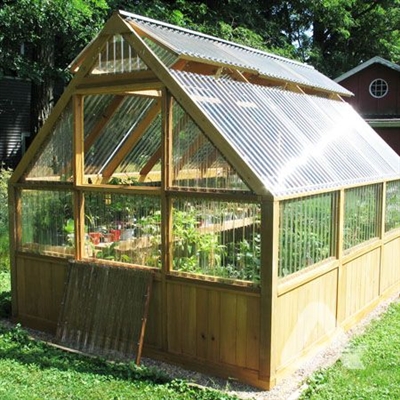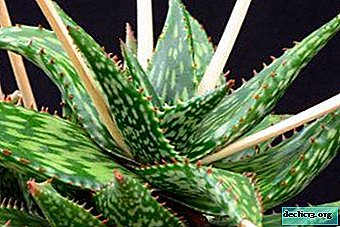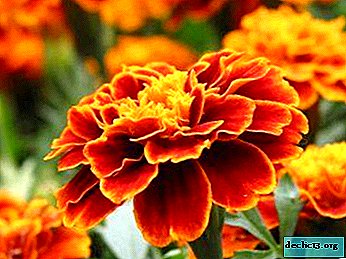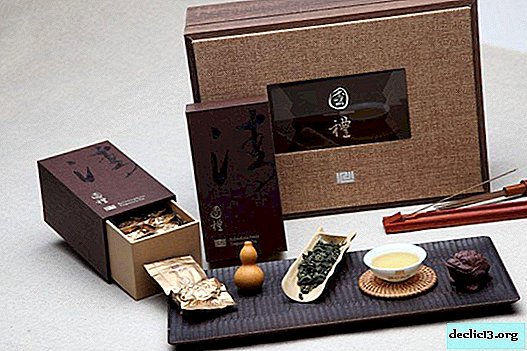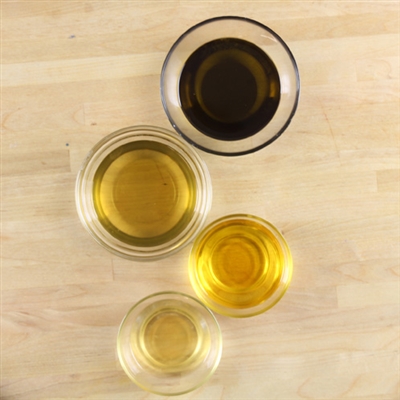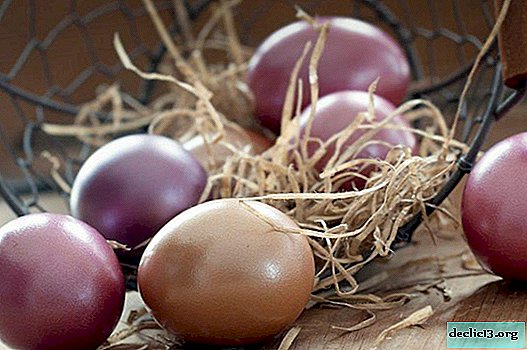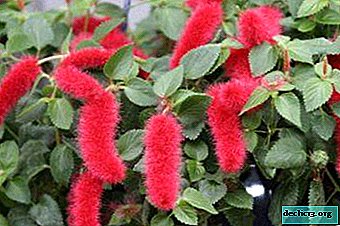A blossoming miracle on your windowsill is an ayloster cactus. Description, types and varieties of home and outdoor care

Among the flowering succulents and cacti, the ayloster boasts strong bushiness, endurance and high decorativeness.
A unique cactus, for the flowering of which a minimum of effort is applied, conquers flower growers with its unpretentiousness.
Further in the article we will tell about the history of this plant, about what species and varieties are, as well as about the rules for caring for a cactus and its diseases and pests.
Iloster - Cactus with Floral Wreath
Ayloster (Aylostera) from the Greek ayloz - tube, stereosis - solid. For many years, botanists have been arguing about combining ayloster and rebucia into one genus (read more about the types and features of care for rebucia here). A cactus novice will not find differences between these types of cacti.
 A beautifully blooming cactus stands out for its high ability to form children, grow, and constantly tiller. Spherical stars with a perfect round shape, undersized. Sometimes you can find a cylindrical shape. The height of the ayloster grows no more than 10, most often 6-7 cm, with a diameter of not more than 6 cm. Slightly expressed low ribs, not less than 11, with small bulges that are arranged spirally.
A beautifully blooming cactus stands out for its high ability to form children, grow, and constantly tiller. Spherical stars with a perfect round shape, undersized. Sometimes you can find a cylindrical shape. The height of the ayloster grows no more than 10, most often 6-7 cm, with a diameter of not more than 6 cm. Slightly expressed low ribs, not less than 11, with small bulges that are arranged spirally.
Multiple thin, heterogeneous spines, 5 to 30 mm long. On one areola, there are up to 30 spines, which makes the cactus fluffy (you can see photos of other fluffy cacti, as well as their names and growing characteristics, here). Flowers are placed on the plant in a ring, like a wreath. Flowers, up to 4-5 cm in diameter. The natural color is red or orange, rarely white (we talked about other types of cacti with red thorns or flowers here). Hybrid varieties with lilac, yellow, and lilac flowers are bred.
Geographical homeland - mountainous areas:
- Argentina
- Peru;
- Bolivia.
History of occurrence
Ailoster and Rebucius, with their unusual appearance, attracted the attention of the American colonialists. In the 16th century, they brought cacti to Europe as ornamental plants.
The first collection of flowering cacti in the second half of the 16th century was collected by pharmacist Morgan in London. The popularity of plants grew due to biological characteristics - unpretentiousness to watering, dry air, as well as beautiful flowering. Iloster was good because in summer, pots of cactus were dug in the garden.
In Russia, private collections were lost after the 1917 revolution, preserved only in the botanical gardens of Moscow and Petrograd. Cactus breeding became popular again in the 50s of the last century.
Popular types and varieties
Muscle (Muscula)
A small cactus with light thin spines, which, as the tillering, forms plantings from the shoots (read more about the varieties and growing at home the smallest cacti here). Bright flowers contrast on the snow-white cover of needles.

Deminuta
Originally from the northern regions of Argentina. The ball reaches dimensions in height and in diameter - 6 cm. The stalk of dark green color has up to 12 light spines 7 mm long. Flowers of red-orange shades, 3 cm in size.

Heliosa (Heliosa)
Spectacular cactus, blooms at 2-3 years of age. Flowers on a long tube grow to 4.5 cm. A lot of bright orange flowers open simultaneously in a few pieces. Often a miniature stem is not visible due to lush flowering.

Kupperiana (Kupperiana)
A dark green ball, between the ribs has small tubercles. They have up to 20 thin spikes 2 cm long. The central spikes are brown in color, the radial spines have a dark tip. Red-orange flowers with a green pharynx. Flowering time from May to July.

Hoffman (Hoffmanii)
One of the rare species, has needles of light tones that cover the stem very tightly. The flowers are bright orange in color with narrow petal-like petals.

Fibriga (Fiebrigi)
Homeland is Bolivia. The stem is spherical, sometimes slightly elongated, shiny, up to 6 cm in height. Radial spikes are white, central - brown. The bunch has up to 40 spikes 1 cm long. In the center there are four needles 2 cm long. The flowers are red-orange, the tube is red-violet, covered with fine bristles. Midsummer is a time for abundant flowering.

Pseudo-minute (Pseudodeminuta)
Green long stems have in a bunch of 10 glassy or white spines from 7 to 10 mm. In the center there are three spikes up to 13 mm, brown or yellow. Flower 5 cm in diameter, burgundy red.

Spegazziniana (Spegazziniana)
It grows in Argentina (Salta, at 2500 m above sea level). A spherical stem with a diameter of 4 and a height of 6 cm. It is distinguished by large beams of radial light spines and a light green color. Central spikes may not be, or 5-6 pieces. The flowers are large, bright, brick red.

False Tiny (Pseudominima)
About 15 radial needles are combined on a cylindrical stem. With age, the needles change color from yellowish to whitish. The flowers are orange, medium in size.

Home Care
There is nothing complicated about growing ayloster. These are mountain species of cacti, which lack minimal care. What to take care of is the cool wintering. Growing and becoming more beautiful from year to year, cacti prove their unpretentiousness.
Temperature mode
The plant feels great in summer heat up to 35 degrees, but in winter it needs coolness. For cacti, the optimum temperature is considered to be a range from 6 to 12 degrees.
When purchasing a plant in a flower garden, it is advisable to clarify the optimal temperature, depending on the habits of the plant. Sometimes new flower varieties prefer to winter at 5 degrees.Humidity and watering
Like any cacti, aylosters require careful watering. They do not like excessive dampness., but they easily tolerate infrequent waterlogging, need protection from water entering the stem. The frequency of watering should depend on the temperature in the room and the intensity of drying of the soil.
- The optimal frequency is 1 watering in 7 days. If the plant is on a sunny windowsill or there is intense heat, then water more often.
- In winter, the frequency of watering is determined by temperature. Humidity is reduced to a minimum, even at room temperature. If the winter is warm and there are children less than 3 cm, then watering is rare and not plentiful.
- With a cold wintering, watering is canceled, limited to a few drops to maintain the vital functions of very young specimens.
- The transition to the winter dry period begins in mid-September and returns to watering in April-May.
 You can not make a sharp transition from a dormant period to abundant watering and vice versa. The volume of water and the number of irrigations increase and decrease gradually, without jumps, allowing the plant to slowly adapt to a new state.
You can not make a sharp transition from a dormant period to abundant watering and vice versa. The volume of water and the number of irrigations increase and decrease gradually, without jumps, allowing the plant to slowly adapt to a new state.
For irrigation use warm, standing water, room temperature. Using hard water for irrigation is undesirable.
Ailoster is tolerant to moisture, but you do not need to keep the plant at high humidity and spray. To clean the cactus from dust, it is better to use a brush or brush.
Lighting
Unlike other cacti, she is not afraid of direct sunlight and prefers sunflowers instead of shade. When choosing a windowsill for flowering cacti, they stop in the southern places. Weak shading for blooming beauties is unacceptable.
Substrate
Suitable soil for growing ayloster is easy to find. Cacti require a special substrate or a light, moisture-permeable mixture for succulents.
For flowering cacti, a mixture of equal parts of sand, sheet and turf soil is recommended.Pruning
If the cactus is not happy with flowering, has acquired an eccentric shape, has ceased to please the appearance or buzz, then you can try to revive it using pruning.
Pruning principle:
- Cut off the top of the old cactus.
- Grind a slice with a sharp blade, according to the principle of sharpening a pencil.
- The sharpened peg should be 1.5-2 cm. The ratio of the proportion of the slice to the plant should correspond to 1 to 3.
- Dry for a week. Without water and soil, the cactus will not die. Drying is a necessary condition for further successful rooting.
- When cropping is performed correctly, the pointed part will be drawn flush with the edges.
Top dressing
Fertilizer will be useful for cacti during the growing period. It is recommended to use mineral complex compounds for succulents and cacti with a low nitrogen content.
Top dressing is done once a month. During dormancy, soil fertilizer is stopped until spring.
Pot selection
 The capacity for the cactus should fit in size. If the drainage holes in the pot are large and the soil pours out, then drainage is laid on the bottom:
The capacity for the cactus should fit in size. If the drainage holes in the pot are large and the soil pours out, then drainage is laid on the bottom:
- expanded clay;
- Styrofoam;
- gravel.
For a plant with a creeping root system, choose a wide, flat dish. If necessary, put pots in pallets.
Transfer
A transplant is best done in March, so that the plant adapts before the start of constant care.Transplant Nuances:
- The transplant is carried out during the beginning of growth, after flowering.
- Young plants are transplanted once a year, adults - once every 3-4 years.
- The main condition is dry soil, which can be moistened after 7 days.
- A transplanted plant is placed in the shade.
Wintering
Maintaining temperature in winter is the main condition for flowering. Without a cold winter, the cactus will not bloom, but will appreciate the speed of growth and attractive appearance. During winter dormancy, the plant loves fresh air and frequent airing, without which they refuse to bloom.
Outdoor Care
Planted in open ground, depending on the weather, the ground is covered with pebbles so that the rain does not erode the ground and does not splash the stems. Care comes down to watering and removing weeds. In autumn, when the temperature drops to +7 degrees, it is time to transfer cacti to the room.
Breeding
 Cactus is propagated in two ways: by seeds and lateral processes.
Cactus is propagated in two ways: by seeds and lateral processes.
The first method is laborious, but interesting, used in early spring:
- prepare the substrate;
- carry out disinfection and drying of seeds;
- seeds are sown in containers, provide air access for rapid germination;
- from the spray gun irrigate the soil;
- maintain a temperature of 15-20 degrees;
- the sprouted sprouts dive into other containers;
- after a year, plants are transplanted to a permanent place.
The second way is much simpler.:
- processes are separated from the cactus;
- dried one day;
- rooted in sterilized sand.
Bloom
A flower tube covered with hairs with shades from orange to bright red. The diameter of the flower reaches 3-5 cm.
After 2 years, flowering ailoster begins:
- The flowering process lasts from April to July, some species bloom in the fall.
- The flowers are bright glossy, open only in clear weather, close at night, bloom for at least 2-4 days and delight with bright yellow stamens.
- Multiplicity - on an adult plant of flowers there can be more than a hundred.
What if the buds do not appear?
- For lush flowering, Ailoster should grow in a tight pot - this stimulates the growth of buds.
- It takes a lot of sunshine.
- Winter rest is compulsory with temperatures up to 10 degrees and the absence of watering.
- Continuous ventilation and fresh air are required.
Diseases and Pests
Lushly flowering aylosters are considered pest resistant. An exception is the spider mite, which is suitable for the conditions of the plant. But this phenomenon is also rare. When pests appear, you need to treat the plants with a weak insecticide solution.
Growing problems
- Loss of rounded shape and stretching of the stem in poor lighting.
- Growth arrest due to lack of top dressing or transplant for more than 1 year.
- Brown spots on the stem from water and direct sunlight.
- Shrinkage of the plant during heavy watering during wintering.
Similar plants
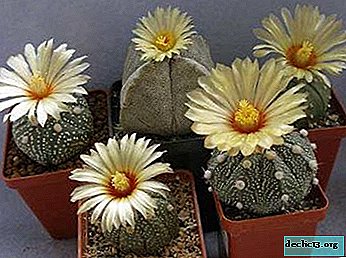 Astrophytum - light gray-green stems, spherical or cylindrical grow from 8 to 40 centimeters, sometimes up to 1 meter. They grow alone, rarely form new processes. Blooms in yellow large funnel-shaped flowers.
Astrophytum - light gray-green stems, spherical or cylindrical grow from 8 to 40 centimeters, sometimes up to 1 meter. They grow alone, rarely form new processes. Blooms in yellow large funnel-shaped flowers.- Brazilicactus - grows in Brazil. Has spherical stems up to 10 cm in diameter, with a flat top. Occurs rarely. Bright orange double-halo flowers appear around the crown in large numbers.
- Mammillaria - spherical stalk with smooth rows of papillae. Small flowers up to 2 cm, daytime. They bloom in pink, white, yellow, cream and white and pink.
- Echinopsis. The spherical shape of the stem is later extended, has smooth ribs, clearly expressed. The flowers are large up to 14 cm in diameter, funnel-shaped in white, pink, orange or yellow (we talked more about exotic cacti with pink spines and flowers in a separate article).
- Notocactus - southern cactus. Spherical stem with clear ribs and a large number of spikes. Flowers of different sizes of yellow or yellow-violet color (learn more about the popular types of notocactus here)
A charming cactus lives and delights with flowering from 7 to 10 years, sometimes longer. One of the most beautiful and flowering plants will be able to grow even a beginner in floriculture. A flower is not uncommon and is available at many flower shops.

 Astrophytum - light gray-green stems, spherical or cylindrical grow from 8 to 40 centimeters, sometimes up to 1 meter. They grow alone, rarely form new processes. Blooms in yellow large funnel-shaped flowers.
Astrophytum - light gray-green stems, spherical or cylindrical grow from 8 to 40 centimeters, sometimes up to 1 meter. They grow alone, rarely form new processes. Blooms in yellow large funnel-shaped flowers.


